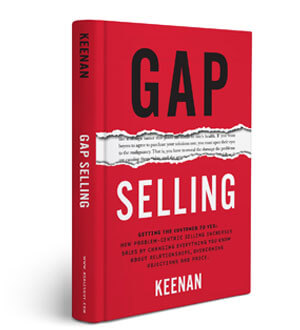Sales Strategy Consulting for Enterprise B2B Sales Teams
When to Step Back and Inspect the Sales Strategy
If deals keep slipping past their close dates, win rates are stagnant or declining despite a full pipeline, or your forecast consistently misses, something in the sales system isn’t working.
The issues show in different ways:
- Reps are active but few deals are progressing
- Pipeline looks strong but conversion doesn’t follow
- Forecasts fluctuate week to week or month to month
- one-on-ones and pipeline reviews don’t lead to measurable change in deal outcomes.
These patterns signal a strategy problem worth inspecting. These patterns usually trace back to weak qualification, missing insight into what drives buyer decisions, and inconsistent sales execution across the team.
Sales strategy consulting starts by isolating those patterns. The goal is to understand what’s breaking down and what has to change to improve performance.
Start Your Strategy Inspection
People We Work With:
What Sales Strategy Consultants Inspect First
Sales strategy consulting begins with a structured inspection of how the sales organization operates: how pipeline is built, how deals move forward, and how forecast decisions are made.
Consultants assess five core areas:
- Sales Process
Are stages mapped to how buyers make decisions? Where do deals stall or fall off? Are reps advancing deals based on buyer movement or arbitrary steps?
- Qualification Standards
What makes a deal pipeline-worthy? Are reps documenting business problems, urgency, and impact or interest and timelines?
- Discovery Execution
Are reps diagnosing underlying issues and linking them to measurable outcomes? Or are they jumping from pain points to demos without defining the problem?
- Forecast Inputs
Is forecast data based on confirmed buyer information? Can leaders track projected revenue back to verifiable details in the CRM?
- Team Structure and Skills
Are roles aligned with how your buyers evaluate and purchase? Do managers know how to inspect real deal quality and coach based on what’s actually happening in the sale?
When these elements break down, win rates fall, sales cycles drag, and forecasts lose credibility. The inspection reveals where that’s happening and why.
Sales Activity High but Results Lagging?
Figure out what’s missing from the strategy
How A Sales Growth Company Approaches Strategy Consulting
A Sales Growth Company applies Gap Selling to restructure how teams qualify opportunities, manage pipeline, and coach execution. The approach is designed to improve win rates, increase average deal size, shorten sales cycles, and strengthen pipeline quality.
Here’s how that gets applied:
- Reps anchor every opportunity to a business problem.
They learn how to identify and document what the buyer needs to fix and why it matters. Opportunities are reviewed based on whether the buyer has defined a problem, explained its impact, and expressed a reason to act.
- The Problem Identification Chart (PIC) drives deal structure.
Reps map the buyer’s current state: including the problem, its impact, and the underlying causes. This structure becomes part of pipeline reviews, coaching sessions, and forecast discussions.
- Qualification criteria are specific and enforceable.
Reps must capture clear signals of buyer urgency, business impact, and internal pressure before advancing deals. Managers use this standard to review pipeline consistently.
- Forecasting uses buyer input as the foundation.
Deal scores are based on what the buyer has shared. Sales leaders use these signals to evaluate deal risk and forecast accuracy.
- Managers coach to a defined framework.
One-on-ones and pipeline reviews follow a consistent structure. Execution gaps are easier to spot and correct when every manager uses the same criteria.
Gap Selling gives teams a way to inspect how deals are being worked and to build repeatable habits around the information that drives performance.
What Makes Gap Selling Different?
Gap Selling is structured around how buyers make decisions. The methodology is built on principles from cognitive psychology and behavioral economics. Specifically, how people recognize problems, process discomfort, and decide to take action.
- Problem-Centric Sales Conversations
Buyers act when a problem becomes real, urgent, and tied to business outcomes. Gap Selling begins with problem identification and focuses on understanding its cause and impact before building a sales strategy around it.
- The Gap as a Decision Driver
When the difference between a buyer’s current state and desired future state is clear, the brain creates tension. That tension leads to focus and follow-through. Gap Selling uses this pattern to drive qualified movement in deals.
- Root Cause Focus
Surface-level pain often hides deeper issues. Gap Selling helps sellers uncover those underlying causes through layered questioning, making the sales conversation more accurate and useful to the buyer.
- Assumption Testing Through Discovery
Many buyers start with a solution in mind. Gap Selling creates space to challenge those initial ideas by bringing in business impact, urgency, and risk, giving both sides a clearer picture of the problem.
- Emotional and Financial Impact Mapping
Every business problem carries emotional and financial weight. Gap Selling connects the dots so buyers understand what’s at risk and what’s possible. That understanding drives stronger engagement and clearer decision-making.
- Buyer Ownership of the Problem
Buyers describe their own situation, define the problem in their own terms, and link it to outcomes they care about. That ownership builds urgency, buy-in, and momentum because action comes from internal motivation.
Gap Selling aligns the sales conversation with how people process risk, seek resolution, and commit to change. It equips sales teams to guide that process with consistency and precision.
Case Studies
Ryan Cannady, CRO of John Deer Employees Credit Union Increased his bank membership
%
Increase in Primary Institution
%
Increase in Membership
%
Shorter Sales Cycle Length
%
Positive Culture Change
trusted by:
Quarter After Quarter, Still Behind?
There’s a reason. We’ll help you find it.


A Little Insight For Ya…
Here are a few tools to get you on the right path forward.
How Buyers Want to be Sold
This survey report shares direct input from buyers on how they prefer to be approached, engaged, and sold to. It highlights what buyers pay attention to, what gets ignored, and the reasons they move forward or walk away. You’ll see clear trends in messaging, outreach, and rep behavior that influence buying decisions.
Use this report to align your sales motion with how real buyers actually evaluate sellers.
Deal Review Framework
This resource outlines a nine-point deal review process anchored in buyer input. It helps sales leaders assess deal quality based on discovery, qualification, decision process, buying timeline, and urgency. Each criterion is designed to surface execution gaps and guide stronger coaching conversations.
Use it to bring structure, consistency, and focus to every deal review session.
Problem Centric™ OS Assessment
This self-assessment gives sales leaders a structured way to evaluate their team’s ability to execute. It breaks down your sales organization across three critical layers: Skills, Opportunity, and Forecasting. Each section contains targeted questions covering everything from methodology and coaching to pipeline visibility and forecast reliability.
Use this tool to inspect how well your systems support rep execution, deal quality, and leadership oversight. The assessment highlights gaps that stall performance and gives you a starting point to prioritize what needs to change first.







